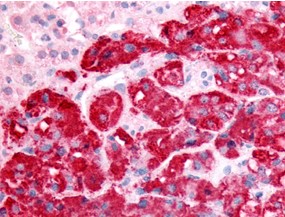Anti-Sphingosine Kinase type 1 Antibody (13810)
Data
- -
- -
Antibody DetailsProduct DetailsReactivity Species Human Host Species Rabbit Immunogen Synthetic peptide conjugated to KLH. Product Concentration Lot Specific Formulation PBS containing 0.1% sodium azide State of Matter Liquid Product Preparation Purified by peptide immuno-affinity chromatography Storage and Handling This antibody is stable at 4°C (short- term) and -70°C (long-term). Country of Origin USA Shipping Next Day 2-8°C Applications and Recommended Usage? Quality Tested by Leinco Immunohistochemistry: Use at 10ug/ml. Each investigator should determine their own optimal working dilution for specific applications. See directions on lot specific datasheets, as information may periodically change. DescriptionSpecificity Rabbit Polyclonal Antibody specific to Sphingosine Kinase Type 1 Background Sphingosine kinase (SPHK) phosphorylates sphingosine to form a bioactive lipid, sphingosine 1-phosphate (S1P). S1P is a novel lipid messenger with both intracellular and extracellular functions. Intracellularly, it regulates proliferation and survival while extracellularly it is a ligand for endothelial differentiation gene 1 (EDG1). Expression of SPHK1 and subsequent production of S1P promotes the G1-S transition, protects cells from apoptosis, stimulates migration and angiogenesis, and induces tumor formation in mice. Antigen DetailsFunction Catalyzes the phosphorylation of sphingosine to form sphingosine 1-phosphate (SPP), a lipid mediator with both intra- and extracellular functions. Also acts on D-erythro-sphingosine and to a lesser extent sphinganine, but not other lipids, such as D,L-threo-dihydrosphingosine, N,N-dimethylsphingosine, diacylglycerol, ceramide, or phosphatidylinositol (PubMed:20577214, PubMed:23602659, PubMed:29662056, PubMed:24929359, PubMed:11923095). In contrast to proapoptotic SPHK2, has a negative effect on intracellular ceramide levels, enhances cell growth and inhibits apoptosis (PubMed:16118219). Involved in the regulation of inflammatory response and neuroinflammation. Via the product sphingosine 1-phosphate, stimulates TRAF2 E3 ubiquitin ligase activity, and promotes activation of NF-kappa-B in response to TNF signaling leading to IL17 secretion (PubMed:20577214). In response to TNF and in parallel to NF-kappa-B activation, negatively regulates RANTES induction through p38 MAPK signaling pathway (PubMed:23935096). Involved in endocytic membrane trafficking induced by sphingosine, recruited to dilate endosomes, also plays a role on later stages of endosomal maturation and membrane fusion independently of its kinase activity (PubMed:28049734, PubMed:24929359). In Purkinje cells, seems to be also involved in the regulation of autophagosome-lysosome fusion upon VEGFA (PubMed:25417698). {PubMed:11923095, PubMed:16118219, PubMed:20577214, PubMed:23602659, PubMed:23935096, PubMed:24929359, PubMed:25417698, PubMed:28049734, PubMed:29662056}.; Has serine acetyltransferase activity on PTGS2/COX2 in an acetyl-CoA dependent manner. The acetyltransferase activity increases in presence of the kinase substrate, sphingosine. During neuroinflammation, through PTGS2 acetylation, promotes neuronal secretion of specialized preresolving mediators (SPMs), especially 15-R-lipoxin A4, which results in an increase of phagocytic microglia. {UniProtKB:Q8CI15}. NCBI Gene Bank ID UniProt.org Research Area Enzymes References & Citations |



